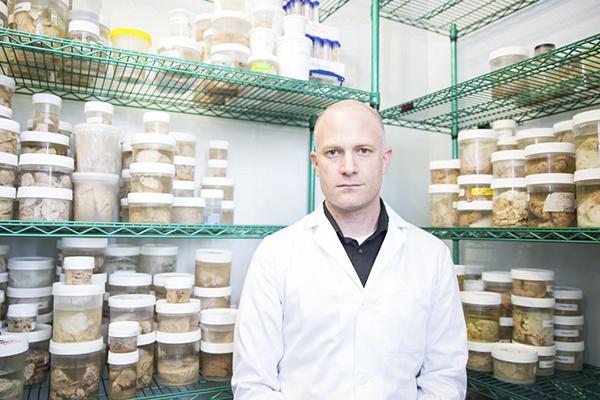Updated: Oct. 21, 2015 at 10:04 a.m.
There’s nothing funny about monkey business in the Science and Engineering Hall.
Researchers at GW have been awarded a grant from the National Institutes of Health to develop the first national chimpanzee brain resource. The faculty hope this database, the first of its kind, will help researchers work together on chimpanzee research, which is underutilized in the neuroscience field.
Finding a way to research chimpanzees is important because their brains are the most similar to those of humans. But it has been hard in the past because of the lack of accessibility to chimpanzees and modern research tools.
Chet Sherwood, a professor of anthropology, oversees the collection of more than 650 mammalian brains including more than 60 different species of primates. Sherwood said the brain repository gives researchers a chance to better understand the human brain and compare it to those of other species.
“It is a really rich resource for scientists, whether at GW or collaborators that come from elsewhere, to try to understand and unravel the differences among species and the similarities,” Sherwood, who is also the director of GW’s Mind-Brain Institute, said.
The brains are stored in a freezer on the sixth floor of the Science and Engineering Hall. Sherwood said that the brain collection represents a 20-year effort of collecting.
“I started my lab 13 years ago and have been collecting brains that entire time,” Sherwood said. “About 6 years ago, I was given the primate brain collection of my former Ph.D. adviser which he had previously assembled.”
Sherwood proposed the idea of making chimpanzee brains more accessible for researchers, and said he received many letters of support and heard from people across the country interested in the resource.
The $1 million grant is spread out over four years. Currently, it is just Sherwood and Cheryl Stimpson, a senior research associate, working on developing the resource.
Sherwood said that by the end of the first year, his team will have a website up with a portal where researchers can find data on MRI scans and tissue samples and make requests for additional tissue samples and behavioral datasets.
The website will have a chimpanzee brain atlas, an MRI-based template of the chimpanzee brain and an open policy for research sharing. Sherwood said he looks forward to working with the Allen Institute for Brain Science, a nonprofit medical research organization based in Seattle, to develop a chimpanzee gene expression map.
Sherwood said not only will students have access to the brain resource, but he will have undergraduate interns in the lab and involve them in the creation of the database.
The National Institutes of Health stopped breeding chimpanzees and began the process of retiring the majority of the NIH-owned chimpanzees in 2013. Sherwood said this project will help neuroscientists continue to make discoveries by enabling research with the brains after their natural deaths.
“We were hoping to further honor the lives of these chimpanzees and increase the scientific value from them after they have died,” Sherwood said.
Brenda Bradley, an associate professor of anthropology, studies primate genetics and is working on a project with Sherwood that will use the brain resource. She said the project will attempt to understand how biological, genetic and physiological variation creates different levels of language skills in different chimpanzees.
“The cool thing for us is that we are not just looking at the genes or the genomes in isolation, we are able to link that data for individual chimpanzees back to the MRI data on the brains and the behavioral data to test for certain behavior or cognition,” Bradley said.
Bradley said she believes the addition of the brain database will be a great asset for the field and for students at GW because it will be publicly accessible, meaning those who don’t have access to a neurological biology lab can go online to gather data and do comparisons.
“That is part of the real beauty of this database,” Bradley said. “It allows for a lot of smaller-scale projects that wouldn’t get done otherwise but can be done now easily by students from all over.”






